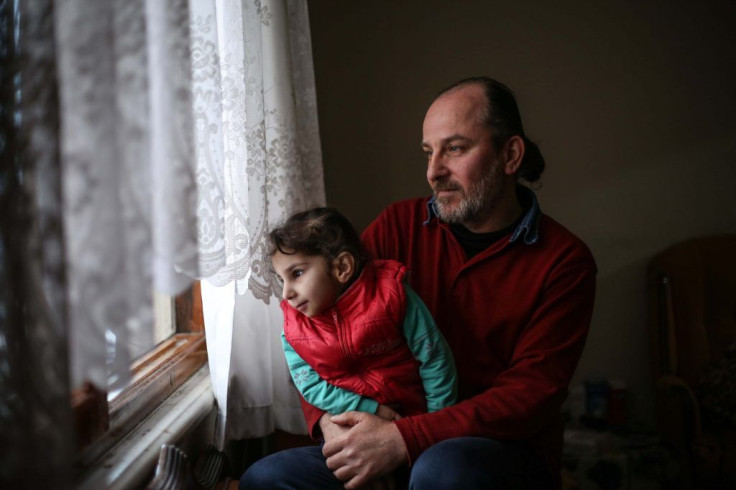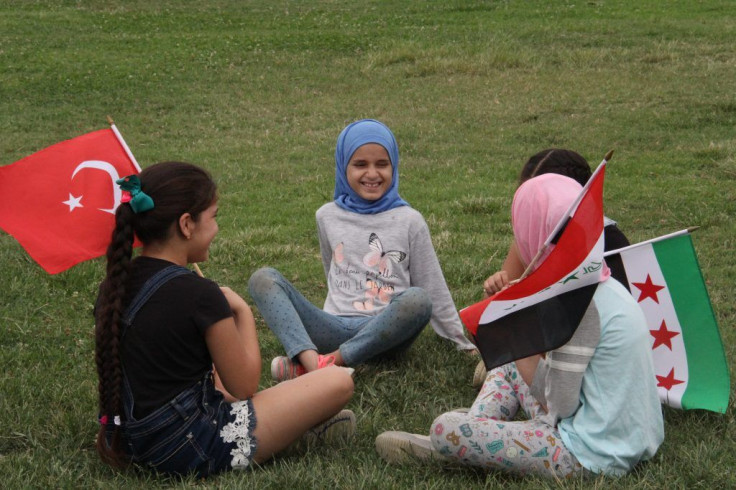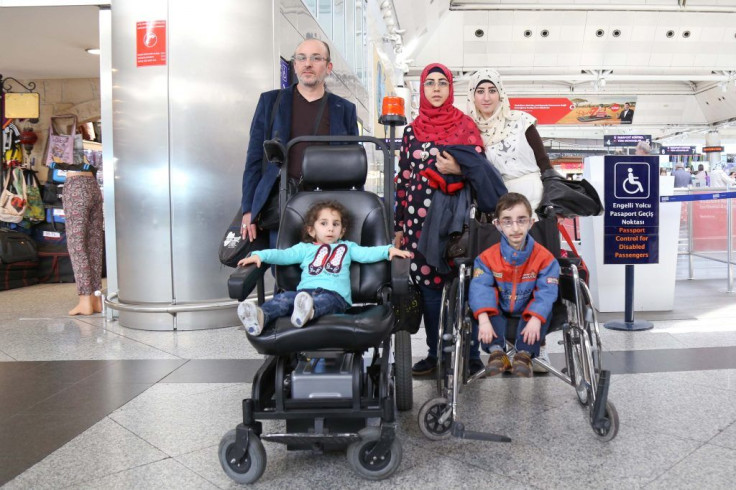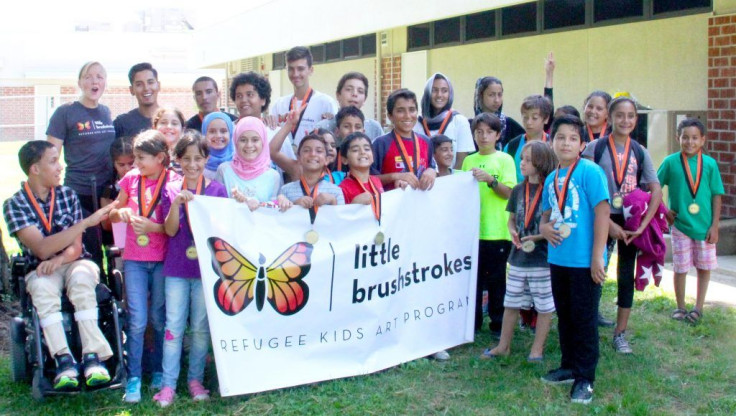Refugees Find Hope In California

This story is being co-published with Capital & Main.
Living in Oakland, scrabbling for work, the young Syrian photojournalist tries to put his life back together. It’s hard. Fearing that he would be forced to fight in the government army, or that he would be harmed because of his photographs of the war, he had left his parents in his home country for Turkey – which is why, fearing reprisal against them, he doesn’t want his name published in this article – smuggling out a cache of photographs documenting atrocities carried out by government forces.
Years of exile followed in Turkey, where he would score a photography job here, another there. The young man waited years for his refugee paperwork to be processed, sharing an apartment with his brother while trying to build the daily routines of a new life. Finally, sponsored by a war photographer in California whom he knew, he secured admission into the United States, arriving shortly before President Trump’s temporary ban on new-refugee admissions kicked in.
After spending years in limbo, the refugee suddenly found things moving absurdly fast. He was given only 10 days notice of his flight to the United States: 10 days to conclude the the relationship he was involved in, to sublet his apartment, to finish the jobs he was doing, to sell or pack or give away all of his possessions.
“I was in a relationship – I should just tell her I will disappear?” he asks. “It gives me a sadness. This is the one I love; I don’t know when I will see her again in life. I don’t know when I will see my parents again. I’m saying goodbye to my brother. Just took one bag. Left everything.”
“I’m already broken inside,” he avers, his emotional rawness painfully clear in every word he enunciates. “I need nice people around. People in California welcome refugees. It’s not easy, to be honest, but it’s my new life. I’m doing my best, but sometimes I feel very tired. Three days ago, I was in the ER. Anxiety. My room is dark, it’s in the basement. I feel far away from everyone and everything. I don’t want to be a victim, but sometimes you feel alone.”
The Syrian photographer is part of the latest, and perhaps for now, the last wave of refugees to come to America after escaping violence. There have, over the past half century, been Southeast Asians, following the Vietnam War; Central Americans fleeing juntas and war; refugees from Iran and the Soviet Union in the 1980s; refugees from Iraq, the former Soviet Union and the Balkans in the 1990s; from African civil wars in the early 2000s; from the slew of post-9/11 Middle Eastern conflicts. Now, all of that human movement is, under the implementation of the new restrictions, grinding to a halt.

After Trump signed his initial executive order barring refugees in January, resettlement agencies reported incoming families being turned back at airports overseas or held in U.S. airports upon arrival. Turmoil reigned as those refugees previously authorized to come to America to escape political or religious persecution in Iraq, Syria and Iran were blocked from flying here. Many had already sold everything they owned, canceled their housing leases, quit college, etc. -- all in anticipation of their move to the United States. Now, suddenly, they were left in limbo.
“I was in San Diego [at] our annual meeting,” Yvette Khani, a caseworker supervisor at the International Rescue Committee’s Glendale office, recalls of the day the IRC heard that the refugee ban was about to kick in. Khani, an Armenian Christian who left Iran as a refugee in 1995, and who has worked for the IRC since 1997, sits in her small office -- on one wall of which is pinned a poster of Albert Einstein, who founded the IRC to help Jewish refugees from Nazi Germany, emblazoned with the words, “Refugees Welcome.”
“They pulled me out,” Khani continues, recalling her colleagues’ reaction to the unfolding events. And, she continues, they “told me 125 of our clients were supposed to depart January 27th from Iran to Vienna -- and told me to call their relatives and tell them not to leave Iran.”
This is a story of contrasts: Of the pain and heartache, the confusion and the delays, faced by refugees caught in the chaos of the Trump administration’s policy changes, and of the opportunities, and the more welcoming spirit that await them if and when they arrive in California.
Despite the occasional anti-refugee protest, no state in the country accepts more refugees than California. Between 2011 and 2016, more than 36,000 settled here, according to the state’s Department of Social Services. Nearly 8,000 arrived in 2016 alone – as did thousands more Special Immigrant Visa holders -- people from countries such as Afghanistan, who helped America during military operations and who are not, technically, refugees, but who can utilize refugee services once they arrive. The latter are concentrated in Sacramento, the Bay Area, Los Angeles, Orange County, San Diego, Santa Clara and a few towns throughout the Central Valley. Sacramento County alone, to where nearly half of the SIVs in the state have come, resettled about 3,300 refugees and Special Immigrant Visa holders in 2016. So far, in 2017, the IRC has resettled another 1,700 or so SIV holders, mostly Afghans, in Sacramento.
The state has, by and large, opened its heart and pocketbook. Earlier this year, Governor Jerry Brown signed into law a bill, authored by Assemblyman Kevin McCarty, that gives schools $10 million over three years to help refugee children in their new educational environment; he also signed Assembly Bill 343, giving SIVs the right to apply, upon arrival, for in-state tuition at community colleges. A state advisory council, made up of refugee resettlement agencies, community groups and members of the Department of Social Services, meets on a regular basis, as do several Refugee Forums around the Golden State.
The federal government, has, historically, also been fairly generous, setting in place a number of programs designed both to bring in refugees from certain countries, and also to help with the resettlement/acculturation process once they arrive. These days, however, Trump’s America is aggressively slamming its doors to them. Trump imposed a “temporary” ban on the entire non-SIV refugee program, severely restricting the granting of visas to people from a number of Middle Eastern countries, and implementing a Catch-22 of “extreme vetting” procedures – on top of the extraordinarily rigorous, three-year process that already existed prior to Donald Trump’s election -- clearly designed to slow to a trickle the migration and visitation from other countries.
“This was a nonpartisan, noncontroversial issue up till the last two years,” says Pastor Kirt Lewis of World Relief Sacramento, which resettled over 1,500 refugees in Sacramento County last year. Then, as Trump ratcheted up his anti-refugee rhetoric, support for resettlement in many states plummeted. “If a lie is repeated enough times, a lot of people will buy it. The Midwest and many Southern states have politically become a hostile environment to refugees.”
“It has been,” he added, “an unpredictable, chaotic environment for those of us who believe this is a matter of character for the kind of country we aspire to be.”

Refugee resettlement agencies fear that Trump's September presidential determination on refugees, which dramatically lowered the total number of refugees admitted yearly to 45,000 – it peaked under Obama at more than 110,000 -- also imposes limitations based both on their nationalities and their “values.”
“We see a lot of risks and threats right now,” says New York-based Anna Greene, senior policy and advocacy director for U.S. programs at the IRC. Greene worries about processing requirements “made so onerous, to get through it really could grind [things] to a halt,” and about a “cherry-picking” of refugees designed to exclude people of certain religious and national backgrounds.
But in California, even as much of the country turns its back on strangers fleeing war zones, refugee organizations report a surge in the number of community residents volunteering time and donating resources to help the new arrivals. Every time Trump tries to hurt this vulnerable population, Californians respond by increasing their assistance. “You drop everything,” says Jose Serrano of World Relief, of the scramble to help incoming refugees after the chaos unleashed by Trump’s initial ban. “You don’t have time for lunch, dinner. You just problem-solve.”
IRC volunteers, such as Sarah Ferguson, a former caterer in Sacramento who now works full time on what she calls a “kindness campaign” –- based around a nonprofit organization that now has hundreds of local volunteers -- have gotten involved in cultural orientations with refugees, in family support services, in little things like showing new arrivals around their neighborhoods, and in big things like helping them enroll children in school. “We have furnished hundreds of homes” for newly arrived refugees,” Ferguson says of her team. “We have done community events where we put out halal food, bring in entertainment. It’s a beautiful feeling. We were all immigrants once. For my family it was my grandparents. We were all once these people in one way or another.”

For World Relief’s Kirt Lewis, in the long-run this community generosity towards vulnerable new arrivals likely means that California, which has nurtured a huge, and effective, refugee resettlement infrastructure over the years – from job training to comprehensive medical screening -- will end up housing a greater proportion of the total number of refugees who enter America. “You’ll see resettlement move away from the smaller and mid-sized communities. Refugee resettlement will increasingly be limited to blue and purple states.”
Out back of the Sarah McGarvin Intermediate School, in the small Orange County city of Westminster, a couple of dozen boys and girls ranging in age from first graders up to teenagers are kicking a soccer ball around, their bicycles parked to one side of the pitch. It’s late summer, and the last day of the Little Brushstrokes World Cup Soccer Camp, which was put together for these refugee children by World Relief staffers and a number of local volunteers. Several days a week, sandwiched between the tennis and basketball courts, they have played soccer, speaking to each other in a mixture of pidgin English, Arabic, Farsi, Pashto. Several of the children are Syrian – part of the last batch of refugees to get into the country before the Supreme Court allowed the refugee ban to take effect this past June. Others are Afghan, Iraqi, Iranian and from a number of other Middle Eastern countries. Some of the girls wear hijabs in a slew of different colors.
The parents of many of these kids work at an assembly plant for medical equipment in nearby Irvine; others work local security jobs; others still are employed by restaurants. Many of the parents speak almost no English; increasingly, as their children pick up their new language, they lean on these children to translate for them and to help them navigate the complexities of life in the new world.
Once the children finish playing soccer, they will traipse over to the shaded copse just next to the main school building, where, sitting in a grassy area bordered by tissue paper hung from tall pine trees, they will eat slices of cheese pizza and chocolate cookies, washed down by Gatorade, while each are given medals for their participation in the summer program.
For 11-year-old twins Maher and Farah, Syrian refugees from a middle-class, business-owning family who spent five years in Egypt before recently being admitted into the U.S. with their parents and grandparents, the program has been a perfect way to begin their new lives in America. “We played soccer. We made friends,” explains Farah, a shy young girl who likes science and sports. She wants to continue soccer after the summer, once they start their new school, playing as a goalkeeper. Her brother, a Barcelona fan who idolizes the Argentinian superstar Lionel Messi, wants to be a striker.
To celebrate their new lives in California, the twins’ parents and grandparents threw them a surprise birthday party earlier that month. Their mother, Hanan, cooked traditional Syrian food -- stuffed grape leaves, chicken wraps, shish barak, tabbouleh – as well as cookies, cake and ice cream. To make their environs look more festive, they hung red and white balloons along the walls of their new apartment.

The party was captured on a cellphone video by Hanan and her husband, Bilal: Maher dressed in a tuxedo, his sister in a white party dress. Their pride shines through loud -- that all-encompassing pride that most all parents, be they Syrian or American, have in their growing children.
When one talks to the family, however, a more enduring sadness emerges from the temporary joy of the birthday. During the Syrian fighting the twins’ parents’ and grandparents’ homes were destroyed, and their businesses ransacked after they refused to allow militias to use their factory supply chain to smuggle weapons. Eventually they had to flee with pretty much only the clothes on their backs.
“I smile in pain and hurt,” the grandmother, Amera, says softly, sitting at a picnic table near the soccer grounds, a three-minute walk from the little apartment they now live in. “I left my house, my belongings, everything. My life there. Daughters, relatives. I am still in very bad pain. Always, I am upset. I remember every day.”
Now, in California, the grandparents are trying to pick up the pieces of their lives at an age when many of their peers are retired, to begin all over again. It’s an awesome challenge for them, and for their working-age children. “We are surprised by a lot of things,” says Amera’s daughter, Hanan. “Financial problems. Getting a job is hard. Learning English. We feel insecure after the new regulations in America; we don’t feel safe. Maybe one day the president comes to us and says, ‘Leave.’ Or doesn’t give us a green card. Then there is no place to go. This is our fear.”
Their stories are by no means unique. Talk to refugees, or special immigrant visa holders, and one hears both tales of heartbreak and a remarkable ability to endure, to start anew, to navigate new pathways.

No matter how much local refugee resettlement organizations want to help these newcomers, they remain largely at the mercy of state and federal policies. And as Trump’s team has both imposed a temporary halt to non-SIV refugee flows, and proposed a long-term cap of 50,000 admissions per year, so one relief agency after another has had to close its idled resettlement offices.
In 2016, for example, World Relief’s Garden Grove office resettled 250 refugees. This year, before the ban kicked in, it resettled 145, and has been told by the organization’s Baltimore headquarters that, even if the ban is lifted it won’t be able to take any more refugees in 2017, because of the numbers cap. Over the last few months, World Relief has shuttered five offices around the country – in Tennessee, Idaho, Florida, Ohio and Maryland.
In 2016, the Glendale office of the International Rescue Committee resettled 1,097; this year it has resettled 668 and doesn’t anticipate being able to bring many more in during the remainder of the year. This year, in the Los Angeles area, three out of eight resettlement offices run by the several organizations working with refugees have closed. Martin Zogg, the director of the IRC’s Glendale office, fears this trend will only accelerate. He envisages “a dramatic contraction” in the number of agencies working with refugees, and a corresponding “reduction in the ability to serve refugees.”
And yet, amidst the nastiness of Trump’s anti-immigrant and anti-refugee stance, California’s politicians and residents have remained remarkably steadfast in their commitment to help and to welcome new arrivals. “That sends a very powerful message to Washington,” argues the IRC’s Anna Greene. “California and other states can do a lot by signaling welcome.”
Karen Ferguson, executive director of IRC’s Northern California chapter, agrees. “California is just continuing to be as positive a place in the midst of this very negative rhetoric as possible. You feel it every day here. I am so proud of this state. We all should be.”
© Copyright IBTimes 2024. All rights reserved.





















